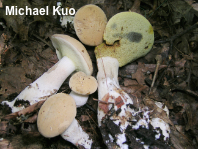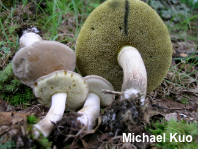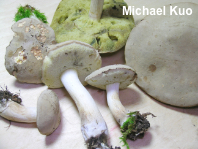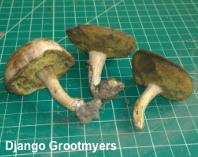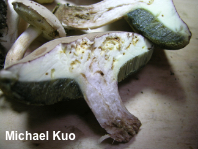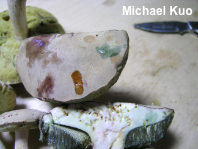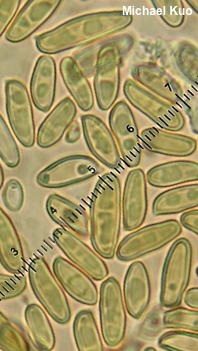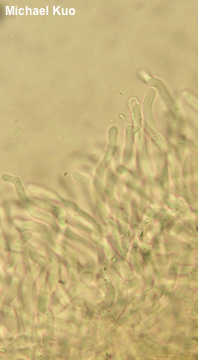| Major Groups > Boletes > Imleria pallida |

|
[ Basidiomycota > Boletales > Boletaceae > Imleria . . . ] Imleria pallida by Michael Kuo, 14 June 2023 Does the pore surface bruise blue? Maybe, maybe not. Does the flesh turn bluish on exposure? Maybe, maybe not—or maybe it feels like turning pinkish. Don't mushrooms read field guides and mycological literature to find out what they're supposed to do?! Don't rely heavily on color changes from bruising or exposure to air for your identification decisions with this mushroom (within reason; if your mushroom instantly changes to blackish blue when you slice it open, it's definitely not Imleria pallida). Look for the very pale cap, smooth white stem, yellowish to olive pore surface, and the association with oaks in hardwood forests east of the Rocky Mountains. Boletus pallidus is a former name. Thanks to Django Grootmyers for documenting, collecting, and preserving Imleria pallida for study; his collections are deposited in The Herbarium of Michael Kuo. Description: Ecology: Mycorrhizal with oaks; growing scattered or gregariously; summer and fall; widely distributed and common in North America east of the Rocky Mountains; also recorded from Central America. The illustrated and described collections are from Illinois, Kentucky, Maine, Michigan, and Ohio. Cap: 3–10 cm across; convex, becoming broadly convex or nearly flat; dry; very finely suedelike when fresh and young, but soon more or less bald and kid-leathery; sometimes becoming cracked in age; pale grayish brown; the margin often with a very tiny overhanging sterile portion. Pore Surface: Whitish when very young, becoming pale dull yellow, then olive yellow and, eventually, dark olive brown; bruising dull blue, or sometimes not bruising; 1–2 xerocomoid pores per mm at maturity; tubes to 1 cm deep. Stem: 3–12 cm long; 0.5–2 cm thick; more or less equal; bald; not reticulate; whitish to brownish, becoming more brownish with age, especially toward the base; sometimes flushed with red near the apex or base; basal mycelium white. Flesh: White when fresh, but often becoming yellowish in older specimens; unchanging when sliced, or changing to sky blue or darker blue (sometimes slowly and erratically)—or pinkish to, in the stem base, red. Odor and Taste: Odor not distinctive; taste mildly soapy or bitterish. Chemical Reactions: Ammonia flashing bluish to purplish, then quickly resolving to negative on cap surface; negative or faintly greenish on flesh. KOH dark brownish orange to pale orange on cap surface; negative to orange on flesh. Iron salts blue-green on cap surface; negative to pale blue-green on flesh. Spore Print: Brown with a hint of olive. Microscopic Features: Spores 10–16 x 4–5 µm; boletoid-fusiform; smooth; yellowish in KOH. Basidia 20–30 x 5–10 µm; 4-sterigmate. Hymenial cystidia 28–40 x 6–8 µm; lageniform to fusiform; smooth; thin-walled; hyaline in KOH, or occasionally with golden-globular contents. Pileipellis a collapsing trichoderm; elements 3–8 µm wide, smooth, hyaline to faintly brownish in KOH; terminal cells cylindric with rounded apices. REFERENCES: (Frost, 1873) A. Farid, A. R. Franck & J. Bolin, 2020. (Murrill, 1914; Coker & Beers, 1943; Singer, 1945; Snell & Dick, 1970; Smith & Thiers, 1971; Grund & Harrison, 1976; Smith, Smith & Weber, 1981; Halling, 1983; Phillips, 1991/2005; Both, 1993; Barron, 1999; Bessette, Roody & Bessette, 2000; Roody, 2003; McNeil, 2006; Miller & Miller, 2006; Kuo, 2007; Ortiz-Santana et al., 2007; Binion et al., 2008; Kuo & Methven, 2014; Bessette et al., 2016; Baroni, 2017; Sturgeon, 2018; Farid et al., 2020; Kuo & Ortiz-Santana, 2020.) Herb. Kuo 07319701, 09050202, 08160604, 09150717, 06221004, 08041501, 08261604. This site contains no information about the edibility or toxicity of mushrooms. |
© MushroomExpert.Com |
|
Cite this page as: Kuo, M. (2023, June). Imleria pallida. Retrieved from the MushroomExpert.Com Web site: http://www.mushroomexpert.com/imleria_pallida.html |
